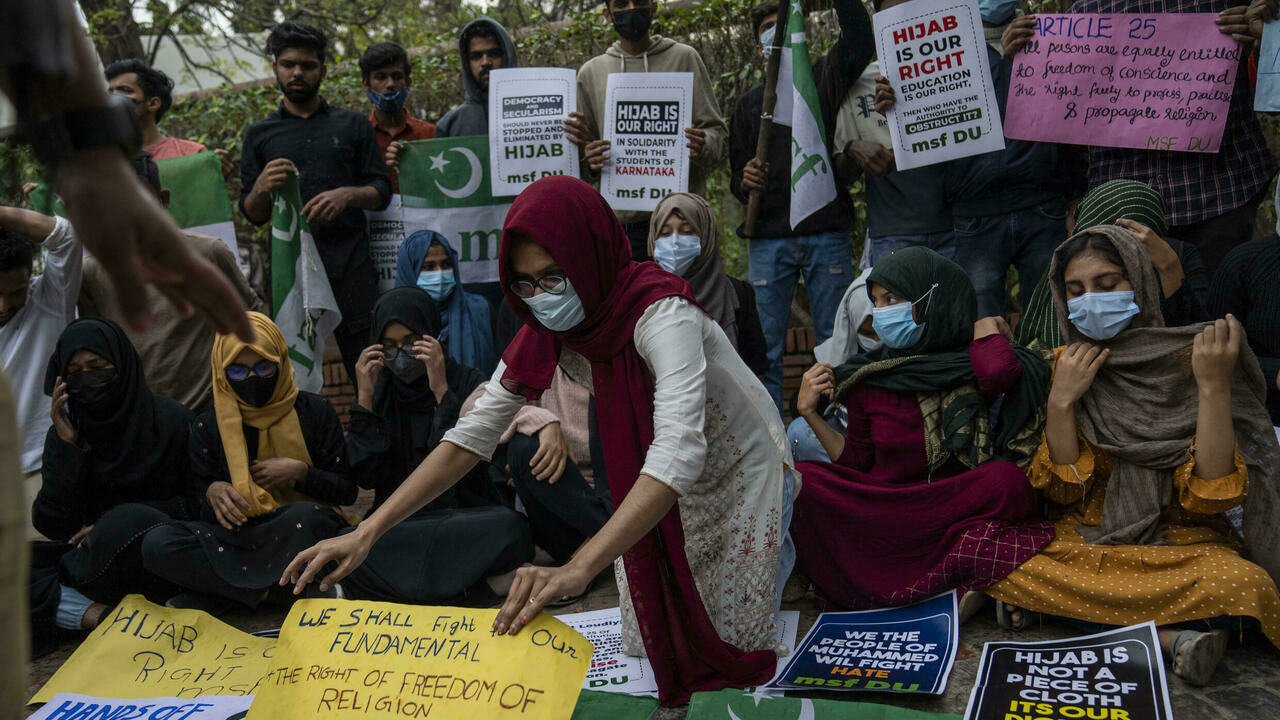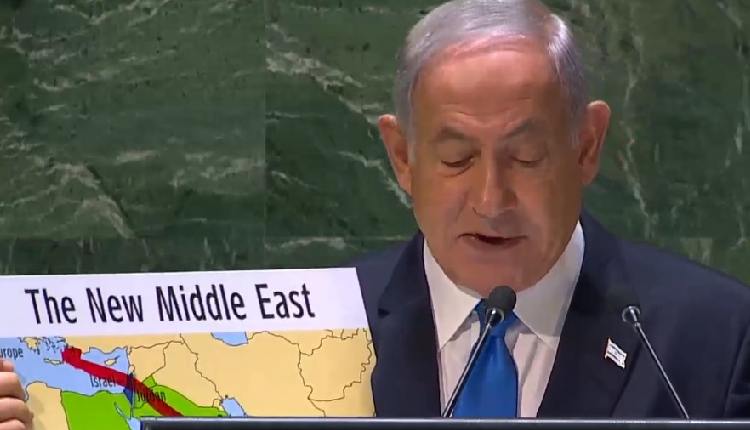
A ban on Islamic veils in schools in a southern Indian state has sparked protests and counter-protests between Muslim and Hindu, raising religious identity issues that have long served the ruling Hindu nationalist party’s electoral agenda as the country’s most populous state holds a critical election.
Advertising Read more
On Tuesday morning, Muskan Khan parked her scooter and began making her way to her college building in the southern Indian state of Karnataka when the Muslim student suddenly turned into the latest symbol of the vitriolic legacy of the state’s Hindu extremist policies.
What happened next was captured in a video clip that promptly went viral, underscoring the febrile, mediatised conditions under which India’s minority youths are being intimidated and forced to defend themselves while being denied basic rights and peace of mind.
Clad in a burqa, Khan was approached by a crowd of shouting young men wearing saffron shawls and waving orange flags – the colours of Hindu nationalist groups that have gained ascendance since Indian Prime Minister Narendra Modi’s Bharatiya Janata Party (BJP) came to power in 2014.
Protests have gripped schools and colleges in Karnataka, a BJP-run state, since an education ministry order banned Muslim girls from wearing the hijab in educational institutions. Tensions have since flared with Hindu students supporting the ban flocking to campuses and intimidating veiled Muslim students with chants praising Hindu gods.
That’s precisely what happened to Khan as she tried to make her way to the college building. As the crowd of young men approached her, hollering, “Jai Shri Ram!” (Hail Lord Ram), the incensed young student raised her arm and screamed, “Allahu Akbar!” (God is great). Furious, she repeated it at the crowd and for the camera before walking into the premises as school security staff tried to control the Hindu demonstrators.
The video clip – with the protest hashtag #HijabIsOurRight – began circulating widely on social media. But so did images of a backlash of saffron-clad demonstrators flocking to schools to mount counter-protests. As tensions across the state rose, the Karnataka state government shut down schools and colleges for three days this week in a bid to restore calm.
A court case has been filed by one of the students, who said in her petition that wearing the hijab was a fundamental right to religion guaranteed by the Indian constitution. The Karnataka High Court has still to issue a ruling.
The hijab controversy has drawn in Malala Yousafzai, the Nobel Peace Prize laureate who survived a 2012 Taliban attack in her native Pakistan for campaigning for girls’ education.
“Refusing to let girls go to school in their hijabs is horrifying,” tweeted Yousafzai. “Objectification of women persists – for wearing less or more. Indian leaders must stop the marginalisation of Muslim women.”
“College is forcing us to choose between studies and the hijab”.
Refusing to let girls go to school in their hijabs is horrifying. Objectification of women persists — for wearing less or more. Indian leaders must stop the marginalisation of Muslim women. https://t.co/UGfuLWAR8I — Malala (@Malala) February 8, 2022
Raking up religion to garner votes
The hijab protests come as India’s most populous state of Uttar Pradesh on Thursday starts a nearly month-long election that is widely viewed as a test of the Modi government. The state’s BJP chief minister, the hardline Hindu monk, Yogi Adityanath, is up for re-election in a race that will be carefully followed across the country.
A strong win would put Adityanath in pole position to succeed Modi as prime minister – a chilling prospect for India’s more than 200 million Muslims.
The polls and electoral math put Adityanath in the lead with the monk-politician attempting to boost his margins on the campaign trail when he explicitly declared the election was a fight between “80 percent and 20 percent”, referring to the state’s demographic split on religion.
The faultlines between India’s Hindu majority and minority Muslims, who make up around 14 percent of the country’s 1.4 billion people, have been widening, and has seeped into educational institutions, straining the fabric of India’s pluralist, secular democracy.
While the Uttar Pradesh capital of Lucknow is nearly 2,000 kilometres away from Bangalore, the Karnataka capital, the hijab row in southern India’s only BJP-ruled state is linked to the Hindu right-wing party’s national electoral strategy.
“This is part of a larger agenda. Certainly, at election time religion is raked up to garner votes. But it’s more than just an election gimmick, the BJP is picking issues to push the [Muslim] community to the wall and to move its agenda of a Hindu country,” said Noorjehan Safia Niaz, cofounder of the Muslim women’s group, the Bharatiya Muslim Mahila Andolan, in an interview with FRANCE 24. “They chose to pick and demonise a whole community as part of the regime’s agenda to convert India into a religion-based country,” she added.
Using religion to veil economic, health failures
The BJP has long employed Islamophobic populism as an election campaign strategy, using symbols to turbocharge its right-wing Hindu base. These include disputed religious sites, such as a 16th century mosque in Ayodhya, Uttar Pradesh, that was demolished by a Hindu mob in 1992 since some Hindus believe it was the birthplace of Lord Ram.
In the run-up to the 2022 Uttar Pradesh vote, Adityanath picked another disputed site, in the city of Mathura, where he promised supporters a project, similar to Ayodhya, was “in progress”.
Using the religious card is particularly useful for the ruling party right now as India reels from economic disruptions from the pandemic, with rising unemployment and inflation sparking protests in some parts of the country.
The government’s handling of last year’s Delta virus wave, which brought the country’s healthcare system close to collapse as hospitals ran out of oxygen, is another issue the BJP would prefer the electorate simply forgets.
The hijab row has impacted education, a particularly hard-hit sector, explained Niaz. “Education has taken the biggest brunt of this pandemic,” she said, referring to school closures and dropouts due to the crisis. “Schools and colleges are places to get an education, not to communalise, otherise and impose exclusionary measures. The singling out of Muslim girls must stop immediately and they must be allowed to exercise their right to education without hindrance.”
Putting identity at the fore
Women’s rights activists are particularly dismayed by the instrumentalisation of the hijab in India, a constitutionally multi-religious country that has so far been spared the sort of divisive discourse on the Muslim veil that has embroiled France and some other European countries.
Communal dress codes are tolerated in Indian society and are not a barrier to entrance into public institutions. Conservative Hindu women in some parts of India still use the ghungat, or veil, to cover their hair, for instance. Other minorities, such as Sikh men, continue to serve in the Indian military with religiously mandated turbans.
As a Muslim woman, Niaz is dismayed by the effects of the BJP’s majoritarian policies on her community. “I am a Muslim woman and I’ve never worn the hijab, my mother has never worn it, my grandmother has never worn it. Hijabs are not among the five tenets of Islam, it is patriarchy in the garb of religion,” she maintained. “But I also understand the freedom of choice, to dress as much, as or as little, as you chose,” she added.
Niaz believes there is a need for a discussion on these issues within the community. “Am I less of a Muslim because I don’t wear a hijab? This is a debate that must happen, but it must happen within the community. The problem is, when you’re faced with such a fascist regime, then we don’t want to debate it. Then we need to stand up collectively against this regime, and so identity comes out more forcefully – and that is not healthy,” she said.
The communalisation of education was on stark display on the streets of Mandya, Karnataka, on Tuesday. When the burqa-clad Khan was trying to make her way to the college building, the chants of the saffron-clad young men harassing her had nothing to do with school rules, ministry orders or women’s rights. They were blunt exultation of religious majoritarianism: “Jai Shri Ram!”
The hapless teenager responded with a counter-chant that was also religious, putting identity at the fore in her desperate bid to access her universal right to an education. “Allahu Akbar,” she shouted, situating the confrontation exactly where communal vote-chasing BJP politicians want it.
Hours later, after Khan had turned into a social media sensation, the teenager was interviewed by an Indian TV station. “Our priority is our education,” she maintained. “Just for a piece of cloth, they are ruining our education.”
Daily newsletterReceive essential international news every morning Subscribe







